Zettel, AI-powered fast note-taking
Little LLM helper to systematise your messy sporadic notes. 🏆 Winner of Innovation Sandbox 2023
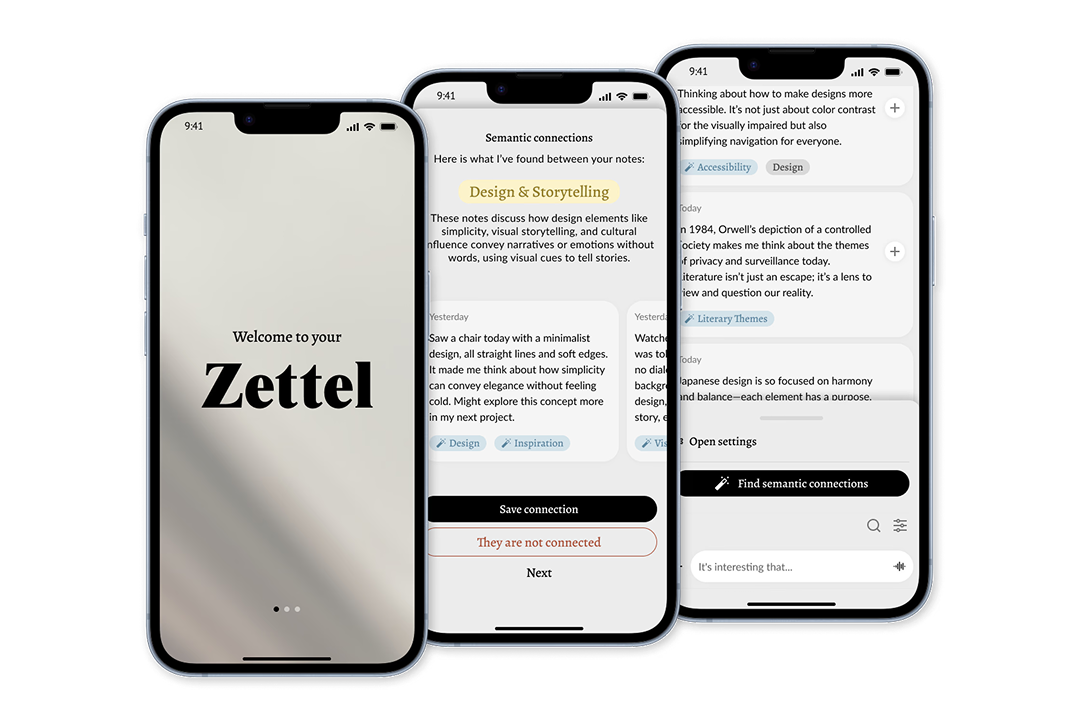
It was long ago, and I was wrong
This concept explores the idea of outsourcing the “connecting the dots” to the machine. While I believe that piles of notes can be sorted and cleaned up, I also believe apophenia — that rare spark of unexpected meaning — is something we should reserve for ourselves.
Project Brief
Zettel is a note-taking app that helps people connect their thoughts using natural language processing. Designed for knowledge lovers, thinkers, and researchers, it encourages flow without forcing structure upfront.
This was a personal solo project from 0→1: research, UX, UI, illustration, pitching — all done by me.
The Problem
Attention spans are shrinking, information keeps growing, and everything is falling apart
Gloria Mark, a professor of information science at the University of California, Irvine, and the author of "Attention Span", has studied how we interact with digital information since 2004. At the time, people could stay focused on a single screen for about 2.5 minutes. By 2012, that number had dropped to 75 seconds. Today, it's closer to 47.
As our attention fragments, the amount of information we consume keeps growing. In response, we’ve come up with personal knowledge management systems to manage the overflow: sticky notes, voice memos, messages to ourselves, Roam graphs, oldschool Zettelkastens, or Tiago Forte’s PARA method.

But tools alone don’t make meaning. We may capture thoughts and excerpts as they come — scattered, half-formed — but the real challenge is in connecting them. How do we return to these fragments and surface insights that matter?
Most note-taking tools focus on capturing — not connecting — ideas. Even power users find themselves manually copying and pasting their notes into external systems, hoping to make sense of it all later.
“I have notes everywhere, but no idea where to start making sense of them.”
Research
To understand how people manage their note taking processes, especially during reading or receiving information in similar ways (videos, articles, podcasts), I conducted a survey and five semi-structured interviews with deep readers, researchers, and note hoarders.
During the interviews, three main user types emerged in my sight:
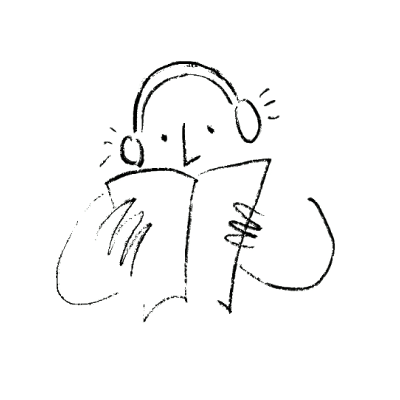
The Curious
Has a reading addiction.
Wants to formulate an opinion.
Answers the questions.
Has no specific goal

The Writer
Prone to ADHD.
Uses a lot of sources simultaneously.
Creative, not always systematic
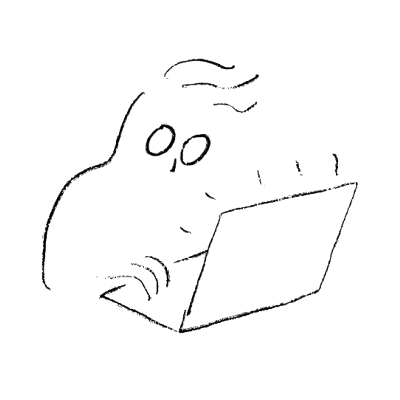
The Researcher
Thorough.
Requires a solid system of sources.
Operates hundreds of files: books, pictures, links, maps.
What they all shared:
- A desire to make connections.
- Difficulty remembering where they read or heard something.
- A patchwork of tools, rituals, and frustration.
Defining the Needs
“I sit down every other Saturday to paste all my notes into my kumu graph. It’s calming… but overwhelming.”– One of the interview participants
From the interviews, four core problem areas stood out:
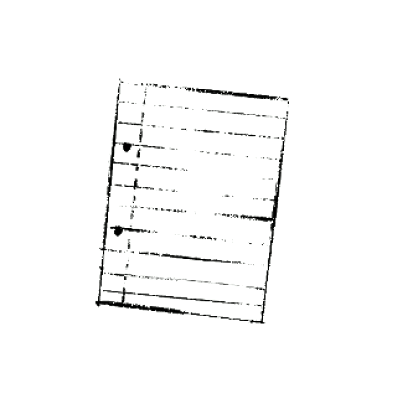
Issues with recalling
“Where did I read that again?”

Disconnected thoughts
“How does this tie into what I wrote last week?”

Planning struggles
“What should I read or revisit next? How will I find this reference?”

Fear of a clean slate
“Do I need to figure out my whole system before I even start?”
How might we…
- Suggest connections across scattered thoughts?
- Make structuring optional and gentle?
- Let users capture quickly, connect gradually?
Zettel offers a more intuitive, assisted way of connecting thoughts:

Assisted structuring
Automated tagging and structuring suggestions.

Assisted linking
Create linked records right away.

Fast referencing
“How can this idea be connected to all the others?”

Easy input
Initially 'flat' structure. No need to bother where to create a new file.
Design Process
As a sole member of the team, I had to use my subtle abilities to create a prototype. I had no technical ability, only Figma. Fortunately, design thinking is not something I had to be taught of.
I'll omit the artefacts on purpose: we all have seen thousands of notes, storymaps, sketches, and wireframes.
Piles of sketches and wireframes slowly turned into prototypes:

The Solution
I focused on mobile-first interactions, imagining real-life use: walking, listening to a podcast, or quickly capturing a thought in a café. So, the journey resulted in a Figma prototype of a solution as simple as your "Saved messages" inbox in messenger, with some twists.

Onboarding flow: from downloading app to opening your canvas

Chat-like UI helps to focus only on the message at the current moment. Add AI-suggested tags right away.

Create nested records. Continue adding your thoughts with analysis of existing context.
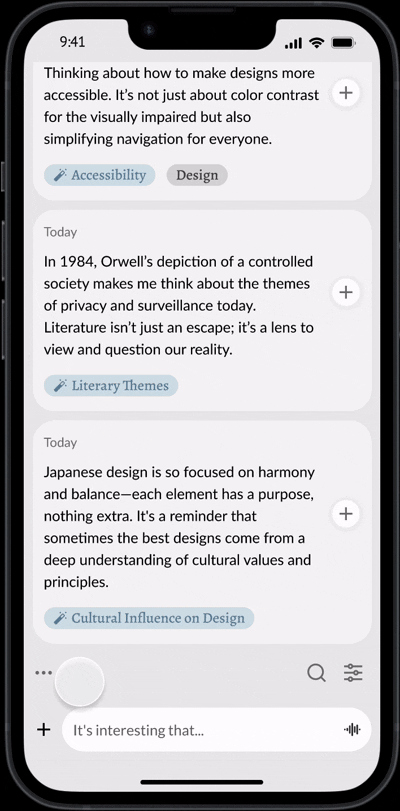
Semantic connection suggestions over time. The system goes through your records and offers the connections that might be not so obvious but insightful.

View the notes in different ways, including the graph view, where you can see connections between the records.
Outcome
Time to pitch! The finale of the sandbox was the public presentation and pitching, demonstrating the whole work: target auditory research, market research, business model (all of them I omitted in this publication) and a prototype.
“I wish I had this during my PhD.”– Max Sandu, Head of Jury
The project won 1st Prize in Coherent Solutions Innovation Sandbox (Autumn 2023)

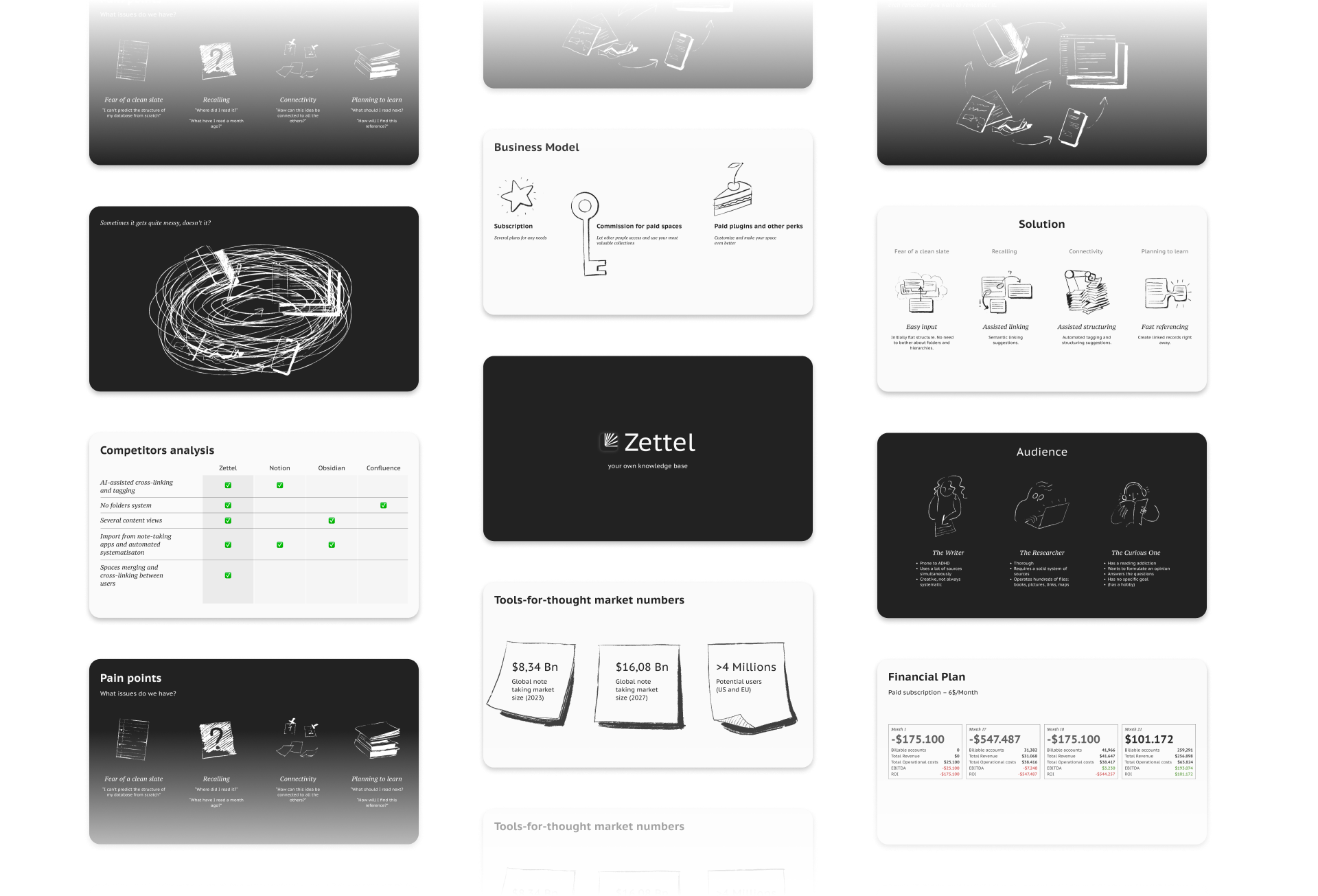
Reflection
What I learned:
- Software is secondary (although the medium is always the message). What matters is learning to actually think (surprise!).
- Community matters. I didn’t fully believe in the idea until I saw others resonate with it.
- It’s not just a product. It’s a question about how we relate to knowledge, memory, and attention.
What's next
I’m continuing to explore how people manage personal knowledge — either by developing this idea further or studying it from a more anthropological perspective. If this resonates with you or you want to collaborate — drop me a message. I'd love to chat.